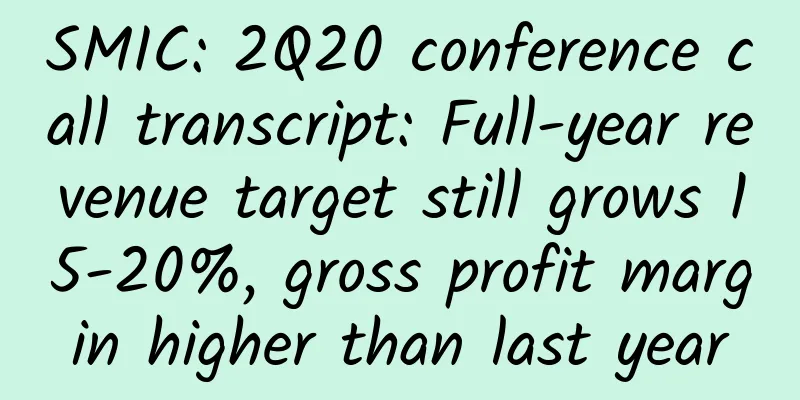SMIC: 2Q20 conference call transcript: Full-year revenue target still grows 15-20%, gross profit margin higher than last year

|
According to the financial report released by SMIC on August 6, 2020, SMIC achieved revenue of approximately US$939 million in Q2, a month-on-month increase of 3.7% and a year-on-year increase of 18.7%; gross profit was approximately US$249 million, a month-on-month increase of 6.4% and a year-on-year increase of 64.5%; gross profit margin was 26.5%, an increase of 0.7 percentage points from the previous month and an increase of 7.4 percentage points from the previous year; the profit attributable to the company was US$138 million, a record high for a single quarter, a month-on-month increase of 115% and a year-on-year increase of 644.2%; basic earnings per common share were US$0.03. The announcement stated that the increase in revenue and gross profit was mainly due to the increase in wafer shipments and changes in product mix. By region, in the second quarter of 2020, the proportion of SMIC's domestic revenue increased significantly. Specifically, revenue from mainland China and Hong Kong accounted for 66.1%, up 4.5 percentage points and 9.2 percentage points from the previous quarter and year-on-year respectively; revenue from the United States accounted for 21.6%, down 3.9 percentage points and 5.9 percentage points from the previous quarter and year-on-year respectively; revenue from Eurasia accounted for 12.3%, down both from the previous quarter and year-on-year. On the morning of the 7th, SMIC executives said in a performance conference call that China's semiconductor industry and Asia's semiconductor industry are getting stronger and stronger. China's local equipment, accessories, and materials have been working hard to develop, but now the scale is relatively small. The company is very happy to see that major companies have been listed and are doing research and development. The company is optimistic about the future, but this takes time. What SMIC is doing now is to innovate with the industry and try to use it, but SMIC is an international company and does not have too much inclination. Mature capacity is tight, capital expenditure increases to US$6.7 billion Before the market opened today, SMIC issued an announcement stating that the net funds raised from the initial public offering of A shares were 45.663 billion yuan (before the exercise of the over-allotment option). The funds raised will be used for the 12-inch chip SN1 project, the mature process production line construction project, the reserve funds for advanced and mature process R&D projects, and to supplement working capital. Zhou Zixue, Chairman of SMIC, said that driven by many new businesses, the long-term demand for the IC foundry industry is strong. The company will plan capital expenditures and capacity construction in a rhythmic manner, make good use of the raised funds, and drive the company's performance growth with continuous innovation. SMIC also stated that the construction target of advanced production capacity is 15,000 pieces by the end of this year. Mature production capacity is indeed very tight at present, and a lot of funds are needed. By the end of the year, the monthly production capacity of 8-inch will increase by 30,000 pieces and 12-inch by 20,000 pieces. The epidemic has delayed the progress of some equipment, but most of the problems have been solved, and production will be reached on schedule and fully loaded, and mature nodes will continue to be improved. The financial report shows that the company's capacity utilization rate for 8-inch wafers shipped in Q2 this year was 98.6%, an increase of 0.1 percentage points from the previous month and 7.5 percentage points from the same period last year. Following the increase in capital expenditure in the Q1 financial report, SMIC's Q2 financial report further significantly increased its capital expenditure plan. The planned capital expenditure for 2020 increased from US$4.3 billion to US$6.7 billion. In this regard, SMIC's Chief Financial Officer Gao Yonggang said that the increase in capital expenditure is mainly to meet customers' demand for advanced and mature processes. In addition, SMIC said in response to questions that the increase in depreciation this year will affect gross profit margin by about five percentage points. There is pressure on net profit from gross profit margin, but the company is also trying to alleviate it. The company expects Q3 revenue to continue to grow by 1%-3% month-on-month, but the gross profit margin will be lowered to 19%-21%. Management added at the earnings conference that the company's full-year revenue target is still 15-20% growth, gross profit margin is higher than last year, and full-year EBITDA is US$1.8 billion. The following is the transcript of the Q&A session: Q: Capital expenditure? Timing of Beijing JV? A: The new capital expenditure is mainly used for the construction of advanced process capacity and the expansion of mature process capacity. SMIC South is in the construction stage, SMIC Beijing, SMIC North 12-inch, and Tianjin 8-inch are all in the expansion stage. The planning of the new project in Beijing is in the planning stage. The company has not been established yet and there is no specific capital expenditure plan. Equipment is purchased normally according to demand and will not be purchased in advance. Q: How much capacity can be increased by capital expenditure in the next 1-2 years? As the gross profit margin was expected to decline, what is the corresponding depreciation of capital expenditure ? A: By the end of this year, the number of 8-inch mature technology will increase by 30,000 pieces, and the number of 12-inch mature technology will increase by 20,000 pieces. In the capacity layout of SMIC South, the increase in depreciation has an impact on the gross profit margin. SMIC South began to depreciate in June. This year, the increase in depreciation has an impact on the gross profit margin of 5 percentage points. Subsequent large capital expenditures will have an impact on the gross profit margin. We will find ways to alleviate the pressure on gross profit margin and net profit margin from all aspects. Q: What is the number of 12/ 14nm FinFET products that have been certified and mass-produced? A: More than 20, including NPW. 5 products are in mass production. Q: What is the reason for the fluctuation in Shenzhen’s production capacity in the second quarter? A: 45,000 pieces, 10,000 power MOSFETs. We have expansion plans to add 10,000 pieces of production capacity. Q: What is the split between advanced processes 1.4 and 2.8 nm ? A: No more splitting. Q: Given that the 8-inch size is in short supply, is there room for increasing the unit price? A: 0.18/0.15 Because the demand for 5G PMIC has increased from 2-3 to 6-8, fingerprint recognition and CIS both require 0.18 process. With innovative products, customers can make good profits, so ASP will rise. SMIC strives to optimize its product portfolio and support customers in developing innovative products. Q: What are the trends and opportunities of 1 4 nm? Feiteng CPU is put into production at SMIC, what is the contribution of HPC? Can it continue to support HiSilicon? A: There are great opportunities in 12/14nm. 4G is beginning to extend to RF transceiver chips and wifi6 mobile phone chips. There are huge business opportunities. We are ready for business opportunities in all aspects. We are confident that we can fill the production capacity. The production capacity is not very large, and the revenue is growing every quarter. We will not comment on a single customer and abide by national regulations. If other customers want to take production capacity, the impact is controllable. 12/14nm is relatively low-end in HPC, and I am trying to think about it. Q: Are suppliers localized? What are the technologies and costs of the equipment? Are raw wafers used in large quantities? A: The semiconductor industry in China and Asia is getting stronger and stronger, and the local support of the ecosystem is a trend. China used to be relatively small, but now it is vigorously developing after listing. The subsequent prospects are good, but it takes time to innovate with the industry. SMIC is an international company and has no specific suppliers, but it also welcomes local production, which is beneficial to the supply chain. An industry leader cannot be replaced overnight, and we welcome overseas leaders to build factories locally. Q: What is the impact of restrictions from major customers on advanced processes? A: The development of advanced processes requires partners and customers. It does have some impact, and we will also look for other alternative solutions. A complete technology is divided into many segments, and different customers are responsible for different links. This challenge can be overcome, and we are optimistic about the demand for advanced processes. Q: What’s your idea of building a factory in Beijing? The demand and profit of 28nm are average, so you want to invest 100,000 pieces of production capacity? A: There is a huge demand for mature processes. Yizhuang South District is not only 28nm, but also 45 and 55nm. It is done according to market demand and customer needs. One is that the customer base has a large foundation. It is impossible to meet customer needs. It is not just 28nm, but a full range, from 28nm to 0.13um, etc., which is customized. In Beijing, we operate multiple nodes and multiple platforms, and we will not build a single-node factory. Integrated circuit manufacturing is the result of historical accumulation. It took more than 10 years for the old factory in Beijing to make a profit. Beijing now has three large bases. It will be easier for three factories to lead one factory, and it will not be as difficult as before. Q: How much of the 6.7 billion capital expenditure is used for advanced processes? A: The increased capital opening is mainly used for advanced processes, with an increase of 30,000 for 8-inch and 20,000 for 12-inch. Capital expenditure has been increasing from 3.1 billion to 6.7 billion US dollars, so the increase is mainly used for mature processes. In terms of depreciation period, regardless of whether it is an advanced process, the accounting policy is the same: 7 years for new equipment and 6 years for old equipment. Q: When will the new production capacity alleviate the depreciation pressure? A: According to the plan. via Futu NiuNiu |
Recommend
The "Pig Trotter Noodles" that ranked first on the "Crazy" food list actually "doesn't exist"?
The popularity of "Kuaishou" has made a...
The marketing secrets behind Perfect Diary’s explosive success
Seizing the opportunity of the rise of domestic t...
IIC: Industrial Internet of Things Artificial Intelligence Framework White Paper
Industrial AI (AI), the application of artificial...
How to build a user operation system: a detailed analysis using Keep as an example
As a leader in online fitness course apps, Keep h...
The entire process of listing on the App Store
App Store listing refers to the entire process of...
The connection between heaven and earth suddenly lost, how much do you know about emergency troubleshooting methods?
On July 25, power supply problems caused the Unit...
Breaking the world record! The Insight-HXMT satellite “saw”…
Recently, my country's Insight-HXMT team disc...
The roasted lamb in Kashgar is so delicious!
Written by Wei Shuihua Header image | Food Photog...
Behind the debut of Dinosaur Star, there are 19 fractures
In the Late Jurassic, an Allosaurus limped toward...
The sandstorm has dissipated, it's time to shatter these "rumors"!
The sandstorm is coming again. Are the Three Nort...
Introduction to Guangdiantong advertising features and backend operations!
Because the background operations are too complic...
A senior designer from Tencent tells his story: How did I grow in the past 8 years at Tencent?
I didn't plan to write this summary. I've...
Huawei App Market search keyword promotion!
1. Introduction to search keyword promotion As on...
Why is Huawei HiSilicon's octa-core processor so awesome?
The day before yesterday, Samsung released the hig...
Model S loses crown in U.S. electric car sales ranking in October
In October, the sales of electric vehicles (inclu...









